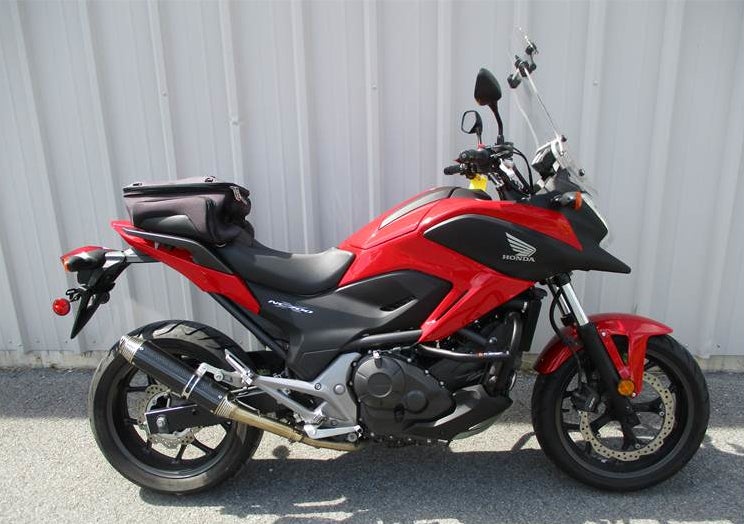I spent a lot of time on the Honda NC700X when it first came out in 2012—a lot of time. I rode one around Newfoundland on a madlad sport touring run, and then took it across Quebec and halfway across Ontario a few weeks later. And, I didn’t really like it that much.
But now, a decade-plus later? I’m beginning to rethink my earlier experiences.While the bike’s drawbacks are still there, it also has some good points that are probably a lot more valuable now than they were in the Obama years.
Penny pinching program
When Honda brought the NC700 series to market, the talk was all about frugality, savings and practicality. Much of the design was lifted from other Honda machines. Inspiration came from the car lineup and the scooter lineup. Honda introduced the NC700S and NC700X at the same time, which both used the same basic chassis and engine. Many parts were engineered to be strong and high-quality, but also low-cost. Even the engine itself was designed not to be just fuel-efficient, but… overall-efficient? For instance, the camshaft drove the water pump and the counterbalancer drove the oil pump. As you’d find in a car, a single throttle body fueled both cylinders; the exhaust manifold was built right into the head (Honda hid this ugly mess with some almost-as-ugly plastic). And, most notably of all, the rev limit was very, very low.
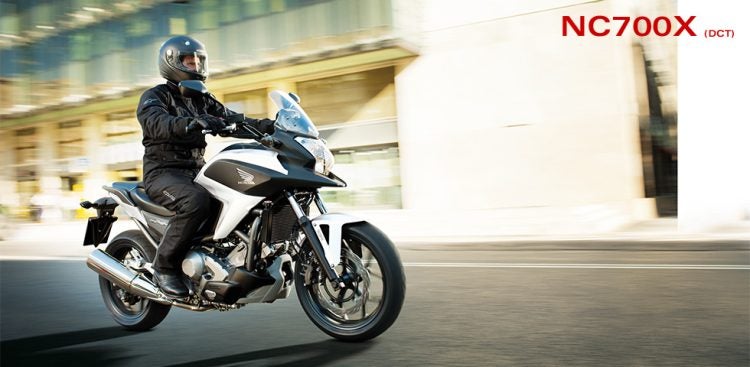
Honda also put its auto-shifting DCT into the NC700Xm as as an option. With the low-revving nature of the bike, it might have been a great fit, but that tech was less-loved a decade ago. Photo: Honda
The 670cc parallel twin made a claimed 46.9 hp and 61.4 lb-ft of torque, and it made those numbers at 6,250 rpm and 4,750 rpm respectively. The real story was how much power it made right off the line. You barely had to crack the throttle open, and the NC was chug-chug-chugging along, nice and smooth—until you hit the rev limiter at 6,500 rpm.
In an era where most parallel twins would put up with quite a bit of throttle abuse, the NC would shut you down quick. If you pushed much past its 4,800 rpm sweet spot, you’d slip into the rev limiter zone before you realized it. For someone like me, used to a pile of rattling haptic feedback from single-cylinder dual sports, the NC engine was most frustrating. It felt like you should be able to rev it a lot longer, as there was no menacing build-up of vibration as the revs rose—but bam, there was the rev limiter.
It was frustrating, at least for me. However, it kept your throttle hand in check, and that meant the NC series got excellent fuel economy. If you babied the throttle, 70 mpg or more was possible.
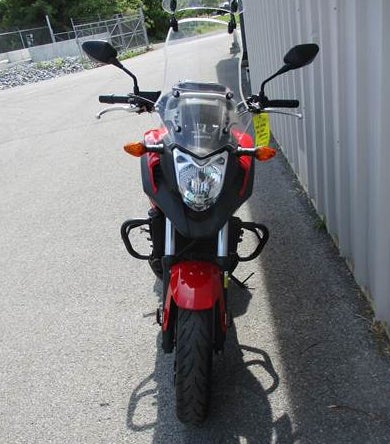
This example has a few basic add-on, but doesn’t come with the factory luggage rack, alas! Photo: Sportline Power
Other petty annoyances
That 70 mpg was a good thing if you were touring, because fueling up could be a major hassle. The Honda’s fuel tank fill was underneath the pillion seat (the traditional in-front-of-the-rider gas tank position was occupied by a storage compartment—more on that later).
If you didn’t have a luggage rack, and you were touring, the Honda could be a serious pain at the pumps. Not because of the hit to your wallet, but because it would take a good chunk of time to unstrap your throw-over bags, remove them, flip up the seat and refuel the bike, then reverse the process.
On other gas-in-back bikes from machines like KTM, Husqvarna or BMW, you can generally access the fuel fill cap without too much jiggery-pokery around your soft luggage, but it was nigh impossible with the Honda.
While the machine was marketed as a sort of adventure bike, the 17-inch front wheel, not to mention the cast rims and road tires, meant that it was realistically a pavement machine, not much more capable on a gravel road than just about any other naked bike.
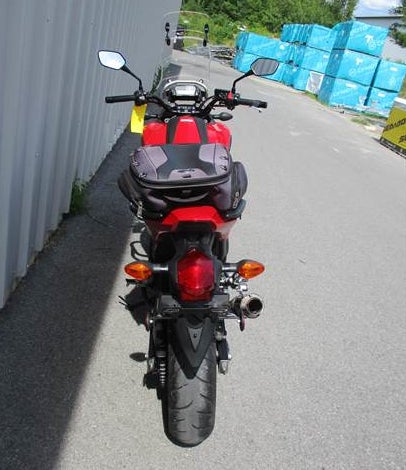
Every time you fuel up the bike, that tailbag will come off with the rear seat… Photo: Sportline Power
The annoyances continued. The long-termer I rode ended up with some annoying squeaks in the bodywork; there was an issue with the odometer re-set button at one point. If you needed to lift up the bike for chain maintenance, the undercarriage was cluttered and didn’t really give you much of a hard point for a jack. The seat was uncomfortable (admittedly a subjective complaint, but one that my friends shared when they borrowed my bike, and I agreed with their prognosis). It sounded like a scooter, the gearbox wasn’t as smooth as you’d like…
None of those concerns are deal-breakers, but through my months on the NC700X, I felt like the designers had emphasized cleverness over real-world practicality.
And yet, the bike had some highly practical points—not just the excellent fuel economy, but also the onboard storage compartment.
Down the hatch!
Instead of a fuel tank in front of the rider’s crotch, the NC700X had a large storage compartment. Open the hatch, and there was enough room in there for a motorcycle helmet… or a pile of groceries, your school bookbag, your gym clothes, a bucket of KFC, whatever. If you packed light, you could throw everything you needed for a weekend of moto-touring in there.
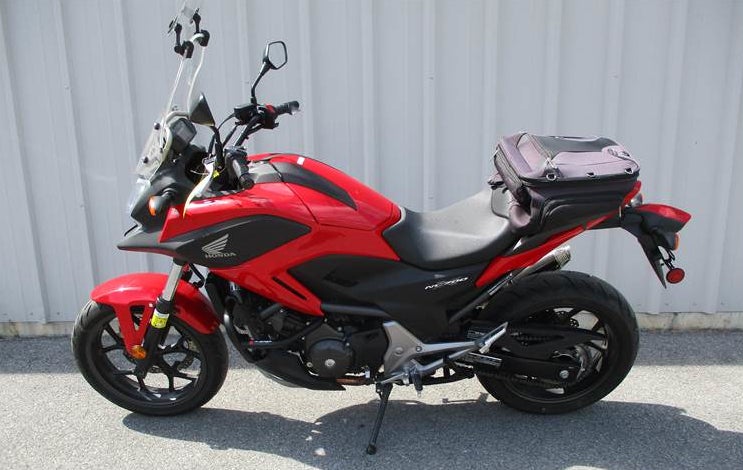
The NC has a built-in storage compartment in the space where most motorcycles hold their fuel. Photo: Sportline Power
This is the feature that I think would be most useful to motorcyclists today. In an age where cars are constantly broken into in cities and towns, with no real pushback from law enforcement, a bike without traditional storage might be the only way your belongings aren’t pinched while the machine is parked.
The long-travel suspension is also extremely useful if you live in an area with crumbling infrastructure. The suspension is budget-friendly, not for nailing whoops at high speed, and you’d pay the price if you flogged this bike on a potholed road, but it was comfortable and stable if you kept to a sensible speed.
The NC700X in 2023
Twelve years after its launch, the NC has disappeared from motorcycling’s public discourse. I expect most of the models Honda built are still on the road, though, and you do seem them come up for sale regularly, even if there aren’t a whole lot of them out there.
The one pictured here is for sale at a dealership in Queensbury, NY, for $4,995 (see the ad here). With 13,513 miles on the clocks over the past nine years, it hasn’t really been ridden much. I’m not sure I’d want to spend five k on an older NC, particularly as it doesn’t come with any sort of tail rack (although it does have a tail bag). But if you’re in the market, maybe it’s worth a look? For those who want the NC700X’s unique blend of features, the chance to buy a low-mileage version will disappear over time.


